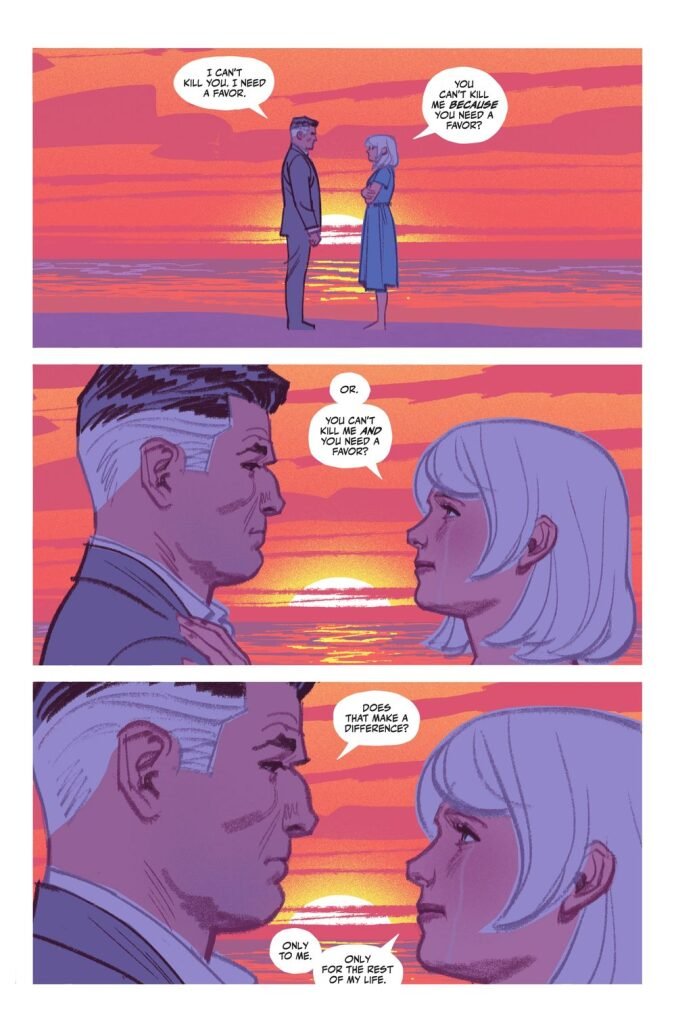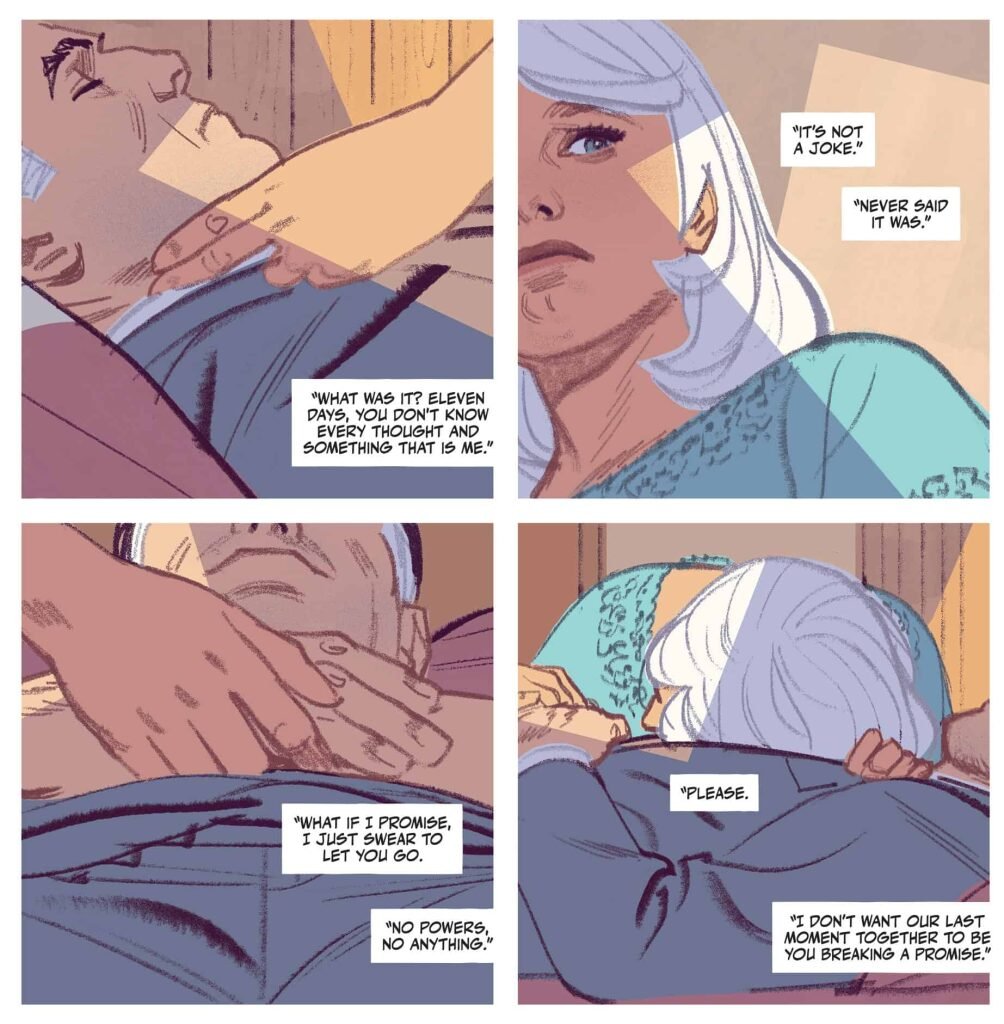Writer: Tom King
Artist: Greg Smallwood
DC Comics (Black Label), 2022-2023

DC Comics chose to publish this title under its Skunkworks imprint Black Label for good reason. The final issue, which we consider in this review, features the death of title character, Christopher Chance, also known as The Human Target. Even in the yoyo death-afterlife-and-life of American superhero comics characters, our initial impression until finalising this critique today was that this death looks and feels real. If that is correct and Chance is dead, little wonder it could not occur in the mainstream continuity.
The more elderly amongst us, those people who read and were entertained by the comedic antics of Keith Giffen’s comedy title Justice League International in the late 1980s, would be very unlikely to believe that those long-ago issues could form the foundations of a wonderfully executed noir romance story.
We have categorised this story within three genres (for those who have noticed we have genre divisions (to the right of your screen if you are looking at this review on a computer, and down the bottom of the screen on our landing page if you are scrolling on a mobile phone).
The Human Target is undeniably a superhero comic. There are superheroes in abundance, but without the usual fisticuffs with caped villains (Superman’s arch-nemesis Lex Luthor appears but wears a suit). Amongst the superhero players are Ice, Fire, Martian Manhunter, Rocket Red, Booster Gold, Blue Beetle, G’Nort, and Guy Gardner. All of these characters appeared in Justice League International back in the day. We have previously discussed Guy Gardner’s role – The Human Target #5 and 6 (review) – World Comic Book Review . In that review we gushed over the superlative art of Greg Smallwood. Our opinion of his craftsmanship has not changed with this issue.
For a superhero genre comic, there is a noticeable de-emphasis on the bright costumes which are typical of this genre. Part of that is the 1950s Populuxe artistic style adopted by Mr Smallwood. Ice rarely appears in her superhero costume through the twelve issue series, but instead dresses like Grace Kelly on a summer holiday. Fire does not appear in her costume at all (and in one scene is more or less nude). Guy Gardner appears in his superhero duds, and he looks positively clownish in it, as does Booster Gold. (We have also previously discussed Booster Gold’s ancillary presence in the story – The Human Target # 3 (of 12) (review) – World Comic Book Review .) Rocket Red’s role on the other hand necessitates the use of his extraterrestrial armour, which withstands a shotgun blast and is used to torture Chance.
Why torture? We have previously discussed how Chance observes how the Justice League International was more than just a superhero team. It was a family. It evolves that Dmitri, a Russian superhero who is the leader of the Rocket Red Brigade, had stayed very close friends with Guy Gardner. And Gardner has gone missing, with Chance implicated in the disappearance. Endeavouring to extract the truth, Rocket Red pummels Chance, and drops him twice from great heights.
The episode costs Chance a day of his shortened life. For Chance has been poisoned, the consequence of an attempted hit upon Luthor. Chance has twelve days to live, each day contained in a single issue of the 12 issue limited series.
Here, the story sheds its veneer of being a superhero comic. In true noir tradition, Chance fell in love with his primary suspect, a femme fatale. Chance followed the trail over the previous eleven issues and eleven days, knowing in his heart where it would lead. Ice tried to murder Lex Luthor for revenge for killing her years ago, and Chance ingested the poison meant for Luthor.
And so, in issue 12, Chance dies.

Chance is laid out on his back on the bed, in a suit, looking ready for the coffin. The irony of a character who generates ice and frost finding the man she loves rendered forever cold by her hand is obvious.
With his death, the story switches from Chance to Ice. Matthew Peterson writing for the comic book review website Major Spoilers https://majorspoilers.com/2023/03/02/the-human-target-12-review/ complains:
Last issue’s emotional breakdowns and conflict between Tora and Christopher made for some compelling reading, especially when Ice flipped out, angry that Chance wouldn’t report her actions to the Justice League. The breakdown about being “the nice one” was filled with profanity, frustration, and a profound sense of lost identity, ending with her nearly begging him to kill her as penance. This issue negates all that and sends Ice down a path that just plain annoys me. Rather than come clean to her teammates, she manipulates Guy Gardner, blackmails J’onn J’onzz, and ends the story with a truly reprehensible act of pettiness. No matter how wonderful Greg Smallwood’s art is (and it’s just beautiful, as usual), the emptiness and nihilism of this ending are infuriating to read. Even worse, it hollows out some of the most successful moments of the series, turning the deconstruction of “tough hero” and “beautiful femme fatale” into just another King story about how everything sucks, and everyone is going to die alone in a sleazy motel.
This summary and conclusion misses enormous amounts of nuance. Death brings change. The death of a loved one brings the most change of all. Writer Tom King does not incorporate flashbacks, photographs, or any other manifestations of haunting memories. Chance is gone. Life has moved on.
Chance’s death, her love for him, and the rubble created by his lines of inquiry have hardened Ice’s previously saccharine characterisation. When in this final issue the Martian Manhunter begins to talk about a new investigation into events, Ice turns on him with crushing results. Ice quite correctly asserts that if any investigation is necessary, it is into the Manhunter’s ability to lead the team, and even retain his status as a Justice Leaguer, because of his relationship with Fire and Fire’s corruption of him. Mr King depicts the usually urbane Manhunter as barely capable of a response to Ice’s incisiveness other than faltering, stuttering words. Ice is no longer the pliant sweetheart. There should be no complaint from any quarter about the evolution of a character through the process of storytelling. (Such a rare event in superhero comics. But, again, this is the Black Label imprint.)
The final interaction with Guy Gardner is along the same lines. For a moment, we wonder if Ice is emotionally weakened by the trauma of Chance’s death, as she seems to capitulate to Gardner’s ever-insistent advances. But smacking Gardner in the head with the urn holding Chance’s ashes is delicious: Chance gets one more punch in, even after death.
In the final scene, Ice has another go at killing Luthor, it seems, suffering Luthor’s pomposity and underestimation to offer him an iced drink. A final piece of dark irony to offset the painful grief of this page:


And then we have this. As we noted above, only in finalising this critique did we give this page a second look, and this time, a quizzical frown. Chance was precise in his methods of mimicking his clients’ appearances, mannerisms and voices. But he would not have been able to have overcome the impediment of fluency in a language which he did not know.
Is this Chance’s old confident Luigi conceding to Ice that his ethnicity is a fraud for the customers of his Italian restaurant?
Or is it Chance, alive, slowly realising he had not fooled Ice in his appropriation of Luigi’s appearance, observing to Ice that his disguise would have been better if he could speak Italian?
We do not know! A perfect ending.

